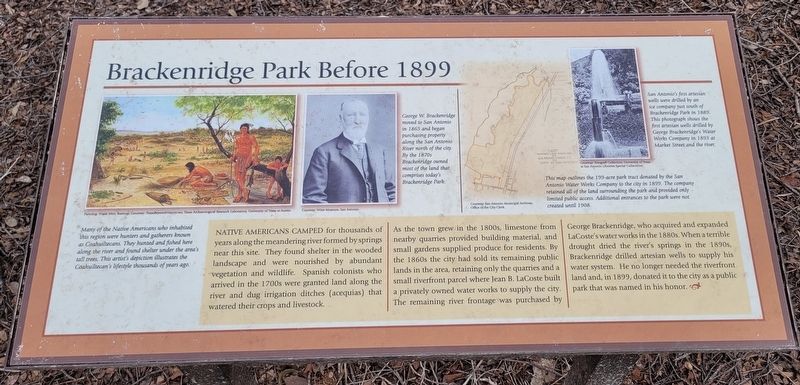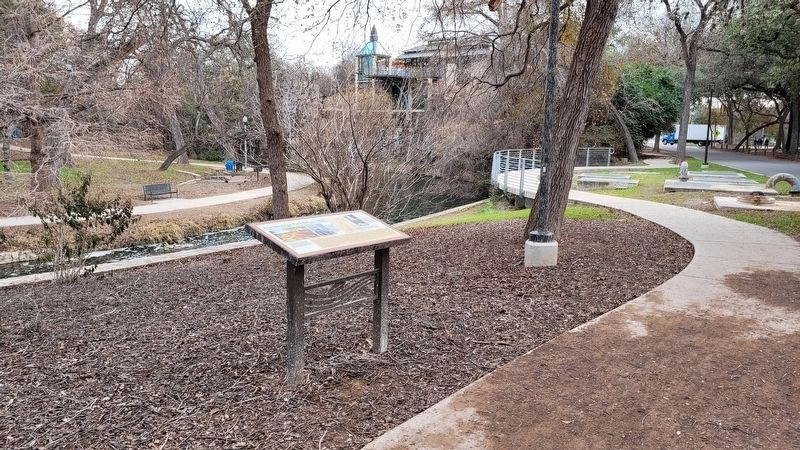Midtown in San Antonio in Bexar County, Texas — The American South (West South Central)
Brackenridge Park Before 1899
As the town grew in the 1800s, limestone from nearby quarries provided building material, and small gardens supplied produce for residents. By the 1860s the city had sold its remaining public lands in the area, retaining only the quarries and a small riverfront parcel where Jean B. LaCoste built a privately owned water works to supply the city. The remaining river frontage was purchased by George Brackenridge, who acquired and expanded LaCoste's water works in the 1880s. When a terrible drought dried the river's springs in the 1890s, Brackenridge drilled artesian wells to supply his water system. He no longer needed the riverfront land and, in 1899, donated it to the city as a public park that was named in his honor.
Captions
Left: Many of the Native Americans who inhabited this region were hunters and gatherers known as Coahuiltecans. They hunted and fished here along the river and found shelter under the area's tall trees. This artist's depiction illustrates the Coahuiltecan's lifestyle thousands of years ago.
Painting; Frank Weir, Bastrop; Courtesy: TexasBeyondHistory.net, Texas Archaeological Research Laboratory, University of Texas at Austin.
Upper Middle Left: George W. Brackenridge. moved to San Antonio in 1865 and began purchasing property along the San Antonio River north of the city. By the 1870s Brackenridge owned most of the land that comprises today's Brackenridge Park.
Courtesy: Witte Museum, San Antonio.
Upper Right 1: San Antonio's first artesian wells were drilled by an ice company just south of Brackenridge Park in 1889. This photograph shows the first artesian wells drilled by George Brackenridge's Water Works Company in 1893 at Market Street and the river.
Courtesy:Zintgraff Collection, University of Texas at San Antonio Libraries Special Collections.
Upper Right 2: This map outlines the 199-acre park tract donated by the San Antonio Water Works Company to the city in 1899. The company retained all of the land surrounding the park and provided only limited public access. Additional entrances to the park were not created until 1908.
Courtesy: San Antonio Municipal Archives, Office of the City Clerk.
Topics. This historical marker is listed in these topic lists: Native Americans
• Parks & Recreational Areas • Waterways & Vessels. A significant historical year for this entry is 1899.
Location. 29° 27.698′ N, 98° 28.139′ W. Marker is in San Antonio, Texas, in Bexar County. It is in Midtown. Marker is on Tuleta Drive, 0.1 miles east of Brackenridge Drive, on the right when traveling west. The marker is located the Joske Pavilion Trail. Touch for map. Marker is in this post office area: San Antonio TX 78209, United States of America. Touch for directions.
Other nearby markers. At least 8 other markers are within walking distance of this marker. Brackenridge Park Since 1899 (a few steps from this marker); The Twohig House (about 300 feet away, measured in a direct line); The Ruiz House (about 300 feet away); Francisco Ruiz (about 300 feet away); The Celso Navarro House (about 400 feet away); The Utility Log Cabin (about 500 feet away); Onderdonk Artist Studio (about 500 feet away); Confederate Tannery (about 500 feet away). Touch for a list and map of all markers in San Antonio.
Also see . . . History of the Park. Brackenridge Park Conservancy
The casual visitor to Brackenridge Park is totally unaware that the 349-acre park, with its picnic areas, ball fields, museum, zoo, and golf course, occupies some of the most historically rich land in the City of San Antonio. Traffic and pavement abound, urban congestion and noise intrude, and interpretation is virtually nil. Nothing tells the visitor that the park represents a long timeline reaching back at least 12,000 years. It is a rich tapestry of history linked by the San Antonio River that rises from springs above and in the park and flows through the park on its southerly course.(Submitted on January 26, 2023, by James Hulse of Medina, Texas.)
Credits. This page was last revised on February 2, 2023. It was originally submitted on January 26, 2023, by James Hulse of Medina, Texas. This page has been viewed 108 times since then and 15 times this year. Photos: 1, 2. submitted on January 26, 2023, by James Hulse of Medina, Texas.

